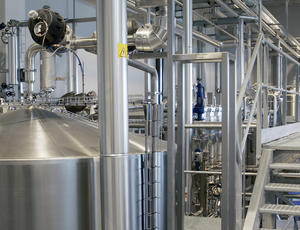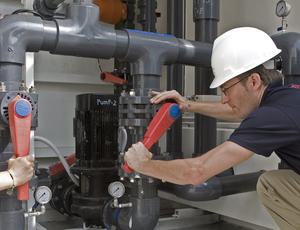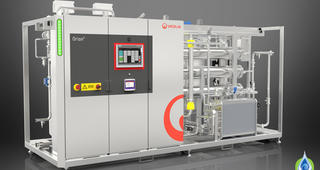Features two packaged distillation systems that reliably produce hot water for injection and pure steam. To give users peace of mind, they are designed according to European and U.S. Pharmacopoeia and European sterilization standard EN285, and feature validated software to ensure compliance.
Overview
At Veolia Water Technologies, we know the availability of pure fluids is crucial for the pharmaceutical and biotech industries when it comes to finished products manufacturing. To meet the needs of our customers, Polaris 2.0 has a robust design and thanks to easy and fast maintenance, it helps to minimize downtime and ensure the availability of high-quality WFI and PS when needed.
How does Polaris 2.0 work?
The Polaris 2.0 range technology is based on high pressure distillation and droplet separation. Sanitization features are available to reduce the risk of microbiological contamination.
The Polaris 2.0 MED is based on high pressure distillation with falling film heat exchange to speed up the preliminary heating phase. The feed water is also used to partially cool down the produced WFI to optimize energy recovery.
The Polaris 2.0 PSG is based on the interconnected water vessels principle where the industrial steam heats up the feed water to the vaporization temperature. A thermal degassing option is available for the compliance with the European sterilization standard EN285.
Both technologies use high-quality stainless steel in the demister for droplet separation.

Features and advantages
- Full vacuum design
- WFI and PS according to EP and USP
- PS in compliance with EN285
- Design according to Pressure Equipment Directive (PED) and EN13445
- Compliance with FDA CFR21 Part 11, ASME BPE and GAMP V
- Double tube sheet heat exchangers to avoid risk of cross-contamination
- Distiller automatic drain and programmable sanitization available
- No chemicals needed during operation
- Process contact material used is stainless steel AISI 316L mechanically polished to reach an average roughness of less than or equal to 0.51 micrometer
- Sanitary tri-clamp connections
- 304 stainless steel frame designed to allow easy maintenance
- Full system drainability and 2D dead leg rule compliance included
- IP54 control panel
- Standard Siemens S7-1500 human machine interfaces (HMI) comfort panel
- Ethernet communication to clients network
- CFR21 Part 11 and GAMP V compliance
- Compatible with our Hubgrade digital solution for remote support
Applications
Services
Our experts are available to provide comprehensive local support and services, strengthened by a global network.
Resources & Product range
Standard MED and PSG models are available as part of the Polaris 2.0 range to meet different capacity demands:

Polaris™ 2.0 MED
Designed for the pharmaceutical industry and biotech applications, it ranges from 250 liters per hour (l/hr) to 4,500 l/hr of WFI assuming 8 barg of industrial steam available on site.

Polaris™ 2.0 PSG
Designed for the pharmaceutical industry and biotech applications, it ranges from 300 kilograms per hour (kg/hr) to 3,000 kg/hr of pure steam at 4 barg assuming 8 barg of industrial steam available on site.
Contact
Our Polaris distiller and steam generation units have long been the go-to solution for pharmaceutical businesses around the world. Polaris 2.0 is an evolution of this tried-and-trusted solution for WFI and pure steam generation with improved performance and efficiency.

Luca Danesi
Chief Sales Officer Europe - Pharma Division
Contact Luca through his LinkedIn account
FAQ about Polaris™ 2.0
Why should I still consider hot WFI production via distillation?
Hot WFI production sensibly decreases the risk of microbiological contamination and biofilm creation. In addition to this, the distillation technology is a very well known process increasing the level of confidence for the end user.
Why should I use an HMI comfort panel instead of a panel PC?
The HMI comfort panel can easily be replaced in case of damage without reconfiguration. Data is saved locally and automatically transferred to your local network. The integration capability of our control platform allows full connection with your network, ensuring a proper data transfer as per FDA CFR21 Part 11.
What is the difference between cold and hot WFI?
The key difference between cold and hot water for WFI lies in the temperature at which the water is produced and maintained.
For example, cold WFI is typically produced and stored at a temperature between 20°C to 25°C and is mostly suitable for applications where there is a need to avoid the potential degradation or alteration of heat-sensitive pharmaceutical compounds. Alternatively, hot WFI is produced and maintained at a temperature above 85°C to 90°C. It is often used for the production plant cleaning in place (CIP) and in processes that require high temperatures to ensure microbial control.
Both cold and hot WFI must meet strict quality and purity standards, including requirements for microbial content, endotoxin levels, conductivity and chemical impurities. The choice between cold and hot WFI depends on the specific requirements of the pharmaceutical or biotech manufacturing process and the characteristics of the products being produced.








